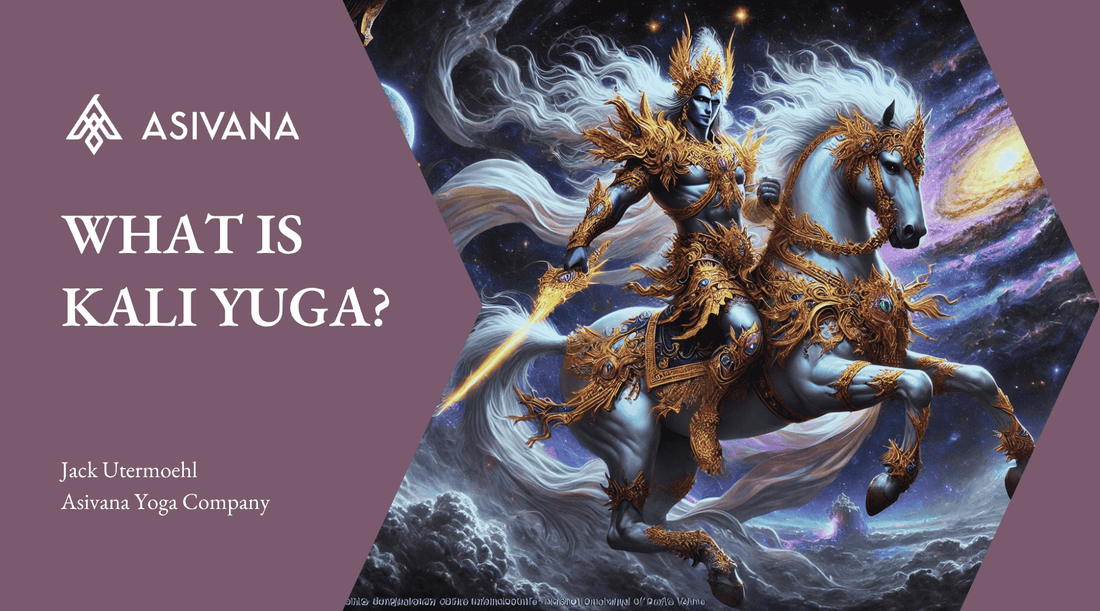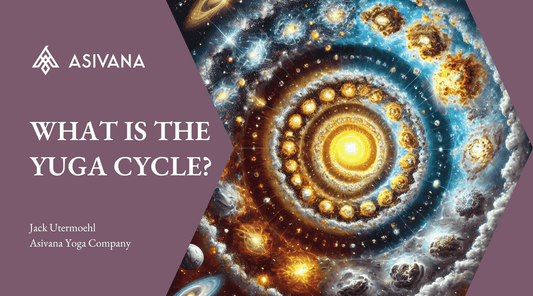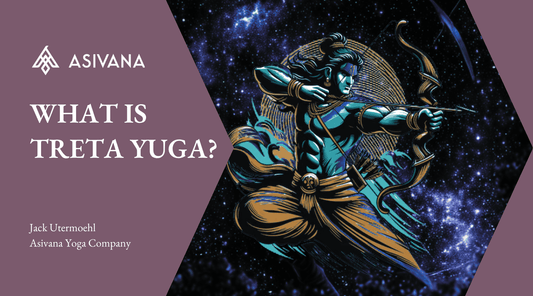
What is the Kali Yuga?
Jack UtermoehlShare
Kali Yuga is the fourth and final age in the traditional Hindu Yuga cycle, known as the Chaturyuga. Often called the age of darkness, conflict, and decline, it is marked by the disintegration of Dharma (cosmic order) and the rise of materialism, illusion, and egoism.
According to the Puranas and the Mahabharata, Kali Yuga is the age in which we currently live. It began with the departure of Krishna from the earth and will continue until the eventual return of divine order through the future avatar Kalki.
Etymology and Meaning
- Sanskrit: कलि युग (Kali Yuga)
- Transliteration: Kali Yuga
- Phonetic Pronunciation: KAH-lee YOO-guh
- Root Meaning: Kali comes from the root word “kalaha,” meaning strife or conflict. It is not related to the goddess Kali, but to the embodiment of quarrel and discord.
In symbolic terms, Kali Yuga represents the era when Dharma stands on only one leg, with Satya (truth) barely surviving while Sauca (purity), Daya (compassion), and Tapas (austerity) have all but vanished. It is an age of moral confusion, spiritual amnesia, and widespread corruption, both internal and external.
Duration and Timing
| Tradition | Duration | Details |
|---|---|---|
| Puranic (Classical Hinduism) | 432,000 earth years | 1,200 divine years × 360 = 432,000 earth years |
| Sri Yukteswar's Interpretation | 1,200 earth years | Part of a 24,000-year Yuga Cycle (Descending & Ascending) |
Date Ranges
Traditional View: Kali Yuga began at the moment of Krishna's departure from Earth around February 17/18, 3102 BCE. Approximately 5,100 years have elapsed, with over 427,000 years remaining.
Yukteswar’s View: Kali Yuga lasted from 700 BCE to 500 CE (1,200 years). We are now in the Ascending Dvapara Yuga.
Scriptural Source References
Bhagavata Purana (12.2–12.3): Offers extensive prophecies about the characteristics of Kali Yuga, including societal breakdown, false leaders, and spiritual decline.
Mahabharata (Shanti Parva 231): Describes Kali Yuga as the age when Dharma stands on just one leg with truth alone remaining, while other virtues have crumbled.
Vishnu Purana (Book IV, Chapter 24): Foretells the rise of greed, lies, violence, and the fall of sacred institutions in Kali Yuga.
Manusmriti (1.81–86): Includes the duration of Kali Yuga and notes the complete erosion of moral and physical integrity in this age.
“In Kali Yuga, wealth alone will be considered the sign of a man's good birth, behavior, and virtues. Law and justice will be applied only on the basis of one's power.”
– Bhagavata Purana 12.2.2
“Dharma stands on one leg only, and that leg is Truth. Even that alone will gradually diminish.”
– Mahabharata, Shanti Parva

Explore Our Full Collection
Discover all the yoga essentials and accessories you need to enhance your practice. Shop now and elevate your yoga practice.
Shop NowDefining Characteristics of the Age
Kali Yuga is defined by rapid moral decay, social upheaval, and spiritual decline. It is the age where ego, confusion, and desire dominate, and humanity lives farthest from divine remembrance.
According to tradition, Dharma now stands on only one leg while the other pillars have fallen away.
| Aspect | Kali Yuga |
|---|---|
| Human Lifespan | Reduced to around 100 years or less, with declining vitality |
| Moral State | Dharma at 25%; deception, lust, and greed dominate |
| Behavior | Hypocrisy, arrogance, material obsession, and spiritual confusion are widespread |
| Society | Corrupt leadership, broken families, loss of traditional wisdom and ethical order |
| Technology & Knowledge | Rapid advancement, but often disconnected from wisdom or dharma |
| Symbolic Dharma Bull | Stands on one leg, only truth remains, and even that is fading |
Despite its darkness, the Kali Yuga is also considered a time of opportunity: spiritual awakening is said to be possible with even small effort, and the barriers to entry for practice are the lowest of all the ages.
Spiritual Practice of the Yuga
In Kali Yuga, the prescribed spiritual practice is Hari Nama Sankirtana, the chanting of the Divine Name. Because of the scattered mind and diminished spiritual focus in this age, meditation and ritual alone are often insufficient.
Bhakti, or devotional remembrance through Nada (sound), is the most accessible and transformative path.
Primary Practice: Chanting divine names (especially mantras like Hare Krishna or Om Namah Shivaya)
Yogic Emphasis: Bhakti Yoga and mantra repetition (japa or kirtan)
Accessibility: Open to all, regardless of caste, gender, or education
Spiritual Tone: Surrender, remembrance, and loving devotion as antidotes to ego and fragmentation
Comparison of Yuga Practices
- Satya Yuga: Meditation and self-realization
- Treta Yuga: Fire sacrifice (yajna) and devotion
- Dvapara Yuga: Temple worship and ritual
- Kali Yuga: Chanting the Divine Name (Hari Nama)
In this turbulent age, even a brief moment of sincere remembrance is said to yield immense spiritual merit. The simplicity of this path is a doorway for awakening in the most unlikely of times.
Avatars of Vishnu in The Kali Yuga
Unlike previous ages where divine incarnations walked openly among humanity, Kali Yuga is characterized by a gradual return to darkness. Yet, the age is not without divine guidance.
Two important manifestations of Vishnu are associated with this era in the form of one that has already come, and one yet to arrive.
Avatar: Sri Chaitanya Mahaprabhu
Role: Hidden avatar of Vishnu/Krishna who appeared in 15th-century India to awaken collective devotion through nama-sankirtana (chanting the divine names)
Symbolic Function: Represents divine compassion and the inward path of Bhakti Yoga making the divine accessible to all, regardless of caste, knowledge, or birth
Sri Chaitanya is considered a combined incarnation of Radha and Krishna, whose life was dedicated to reviving devotional chanting and the power of the holy name. His teachings resonate deeply with the spiritual prescription for this age.
Avatar: Kalki (The Warrior on a White Horse)
Role: Destroyer of evil, purifier of the age, and restorer of Dharma
Symbolic Function: Represents the divine force that arises when all virtue has collapsed and no path remains but renewal through cosmic force
Kalki’s appearance is prophesied to mark the end of Kali Yuga and the transition back into Satya Yuga, thus restarting the grand cosmic cycle. Until that time, the age remains one of endurance, reflection, and inner resistance to collapse.
Modern Interpretations
Many modern spiritual teachers, especially within the yoga world, offer revised perspectives on the Kali Yuga either challenging its timeline or reinterpreting its meaning for today’s seekers.
Sri Yukteswar & Yogananda
In The Holy Science, Sri Yukteswar taught that Kali Yuga lasted only 1,200 years, ending around 500 CE. According to him, we are now in the Ascending Dvapara Yuga, a time of rising energy awareness and spiritual reawakening.
His disciple, Paramhansa Yogananda, echoed this view, framing the scientific and spiritual advances of modern humanity as signs of an upward trend in collective consciousness.
Sadhguru
Sadhguru acknowledges the symbolic power of the Yuga system, but he questions the rigidity of traditional calculations. He teaches that whether or not we are technically in Kali Yuga, the qualities of the age like conflict, confusion, and disconnection are clearly present.
Yet so is the opportunity for transformation. He emphasizes the possibility of consciously transitioning into higher states of awareness.
Symbolic & Archetypal Views
Psychologically, Kali Yuga is the archetype of the shadow age: where ego dominates, systems collapse, and the inner world is fragmented.
Yet it also represents a necessary descent, a phase in which truth must be rediscovered, not inherited. In this view, Kali Yuga is not the end, but the turning point that demands radical honesty, discipline, and the rekindling of faith.
Relevance for Today
Kali Yuga is a vivid reflection of the world we live in now. For yoga practitioners and spiritual seekers, understanding this age offers both a warning and an invitation. It helps us make sense of the chaos while also pointing toward a clear path forward.
This is the age of distraction, misinformation, and spiritual amnesia. Yet, it is also the time when even a small act of devotion carries enormous power.
As the Bhagavata Purana affirms, chanting the divine name in Kali Yuga is more effective than any ritual or austerity from previous ages.
In this way, the “darkest age” becomes the most accessible. Yoga, mantra, meditation, and service are no longer reserved for the elite or initiated. They are available to all.
Reflection prompts:
- Do I respond to confusion and decline with fear or with steadiness?
- What practices anchor me when the world feels unstable?
- Am I willing to pursue truth even when it is inconvenient or unpopular?
In a time when Dharma is barely visible, those who live with integrity become light-bearers. Even if Kali Yuga rages outside, the inner world can remain untouched.
Yoga Essentials for Your Practice
Support your yoga journey with high-quality, sustainable props designed for comfort and stability.

Crafted from eco-friendly cork for durability and a comfortable practice.
$24
Shop Now
Includes everything you need to get started: a mat, blocks, and a yoga strap.
$120
Shop NowConclusion
Kali Yuga is the most turbulent age in the cycle of time, marked by decline and disintegration but it is not hopeless. It is the testing ground for our inner strength and devotion. It strips away comfort and certainty, demanding that we remember the divine from within.
Understanding this age helps us contextualize our struggles and recognize the unique spiritual opportunity we’ve been given. In previous Yugas, great effort was required for small gain. In Kali Yuga, even a little effort bears tremendous fruit.
The yogic path does not deny the darkness of this age but it moves through it with compassion and devotion.
In this way, Kali Yuga becomes a hidden doorway to awakening.










